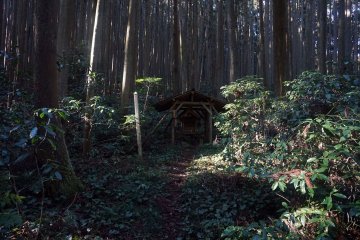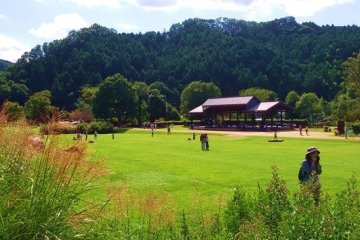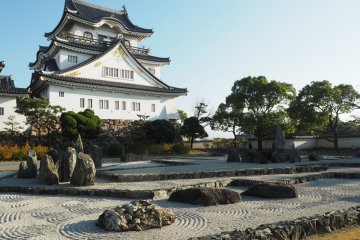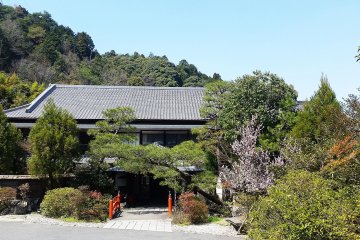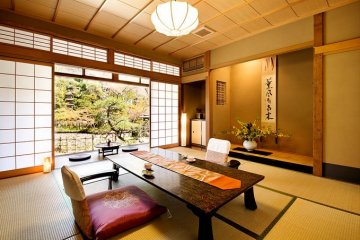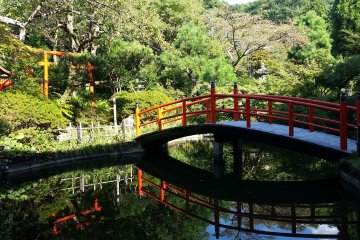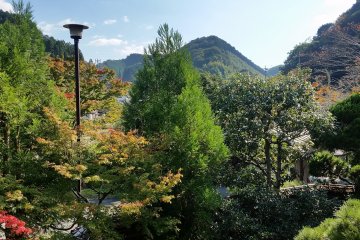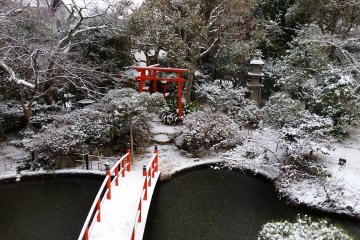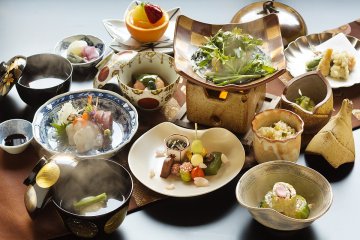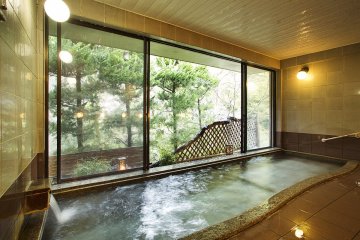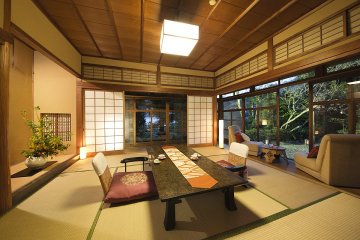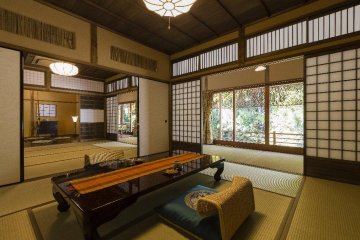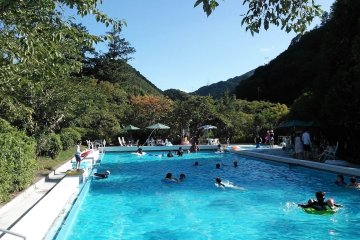Nanten-en is a very traditional ryokan complete with natural hot-springs, deep within the countryside of southern Osaka Prefecture. Surrounded by the forests and hills that mark the border with Wakayama Prefecture, it is hard to believe that one is only 40 minutes from the bustle and bright lights of central Namba.

The main building of Nanten-en is a registered cultural asset of Osaka Prefecture and is around 100 years old. It was designed by the famed architect, Tatsuno Kingo, who is well known for his work on the iconic Tokyo Station as well as numerous other buildings around the country. It was built in an architectural style called Sukiya-zukuri which means Tea House Style.
The Rooms
The main building still bears many of the hallmarks of its late Taisho and early Showa period heritage. While it has been updated and upgraded several times throughout its history, the owners have always taken care to retain the atmosphere of the earlier years. There are only 13 guest rooms within the main building, ranging from 4.5 tatami mats (perfect for a couple) up to rooms with 8 or even 10 tatami mats; some feature additional smaller anterooms that are great for families.

Not all of the rooms have their own bathroom however. The age and listed status of the main building makes it difficult to make large scale changes. "Superior" type rooms have their own washroom with toilet and sink, but the "Standard" type have shared public restrooms. None of the rooms have their own shower, so all must use the showers within the onsen area.
There is one final room which is actually situated in a private annex within the gardens. This VIP style room is comprised of two 8-tatami mat rooms, an irori sunken fireplace, private shower and bathroom facilities as well as its own outdoor hot-spring. It also has its own veranda, overlooking the little Amami River.


The Food
As with most traditional inns, the most common type of dinner is kaiseki, multiple course dinners made up of dainty dishes prepared with the finest local and seasonal ingredients. The menus change on a monthly basis and guests are asked to let the ryokan know of any dietary requirements in advance. Vegetarian, vegan and even plant based and gluten free kaiseki are available on request.

There are other options too including sukiyaki, thin slices of top grade beef fried in a shallow pan with sweetened soy sauce, and shabu-shabu, thin slices of top grade beef or pork cooked in a healthy broth. The winter season also sees the addition of several kinds of nabe hotpots including wild boar and tecchiri, an Osaka specialty made with thinly sliced fugu puffer fish.
Dinner is served in the privacy of your own room and in the morning, a traditional Japanese style breakfast is served in the banquet hall. Breakfast includes a grilled fish dish, rice, miso soup and two or three additional dishes that also change with the seasons.

The Ameneties
Nanten-en has its own hot-springs which are rich in natural radium. This makes them perfect for easing blood-pressure, relaxing tired muscles and softening the skin. It does mean that they are ever-so-slightly radioactive, but not nearly enough to cause any harm! Separate onsen are available for men and women and are open 24 hours a day. Nanten-en is also a tattoo friendly ryokan.

The ryokan is child friendly though a small surcharge is added if they need their own bedding. Children may also accompany their parents to the hot springs and bath chairs are available for infants.
Rooms come equipped with low tables and zabuton cushions as standard but for guests with mobility issues, these can be exchanged for a high table and chairs. There are no elevators in the building so where possible, staff will accommodate mobility impaired guests on the first floor. A wheelchair and a cane are also available for use if needed.
As well as guests staying overnight, lunch packages are also offered where a kaiseki lunch can be enjoyed in a private room followed by a dip in the onsen. These are excellent for people looking for the ryokan experience but without the cost of a full night stay.
Nanten-en also boasts its own private gardens which always change according to the seasons. Spring sees plenty of cherry blossoms and fiery maples in autumn. Summer introduces the lush greens of the rainy season while winter sees the bright red nanten bushes from which the inn takes its name. Starting with the shidare (weeping) sakura at the end of March and finishing with the yaezakura in mid to late April, 5 or 6 varieties of cherry blossom can be found, extending the blossoming season to nearly a month.

One unusual aspect of Nanten-en is its outdoor swimming pool. Surrounded by the forested hills, it is a refreshing oasis during a hot summer. Open daily from 9am until 5pm from mid-July to the end of August, it is free to use for guests with lunch or overnight reservations. It is also open to the public for a charge of JPY 1,500 for adults and JPY 800 for children.

Around Nanten-en there is very little in the way of civilisation. The nearby villages of Amami, Nagaretani and Chihayaguchi are quaint farming communities with many old houses and terraced fields. They feature plenty of local myths and small shrines which are well worth exploring.
The ancient Koya Kaido Pilgrimage trail runs right passed the ryokan and in the mountains just to the south, one can find several small shrines that make up part of a mysterious Yamabushi training route.

There is direct access by train to sacred Koyasan, the famous Buddhist mountain retreat, which is a little over an hour to the south. Many guests will stay at Nanten-en on their way to or from the mountain and is also conveniently placed for day trips. As visitors to Koyasan must pass by Amami Station, staff will happily look after guest luggage while they are visiting the mountain.
Additionally, Kansai Airport is around 90 minutes by train (via Tengachaya Station), limousine bus (via Kawachinagano or Kongo Station) and car.
During the current Covid-19 health crisis, Nanten-en is remaining open and still serving guests. Hand sanitiser is available in the lobby and the staff regularly clean all public surfaces throughout the day. On especially busy days, some guests may have their breakfast served in their room so that we can maintain proper social distancing in the banquet hall.
The People
The owner of Nanten-en is an Omotesenke Tea Master as well as a master of ikebana flower arranging. Each day, he prepares displays of fresh wild-flowers to place in the tokonoma alcoves of the rooms. He regularly holds tea ceremonies with guests, assisted by an English speaking member of staff (often yours truly) where he loves to share his vast knowledge of history and philosophy.

Several of the front desk staff have excellent English and can easily cater for tourists from all corners of the globe. In my own case, as a history buff, I love to talk about the local history, teach guests about ryokan culture and share some of fascinating stories and places of interest.
In addition to the front desk staff, guests are cared for by o-hakobi-san, kimono clad ladies (and one young man who wears a hakama) that serve dinner in the rooms using the proper and sometimes intricate forms of etiquette.
For people looking for an escape from the busy city, or to rest their weary muscles before or after a long flight, Nanten-en is a lovely place to unwind and absorb some real traditional culture and village life.



